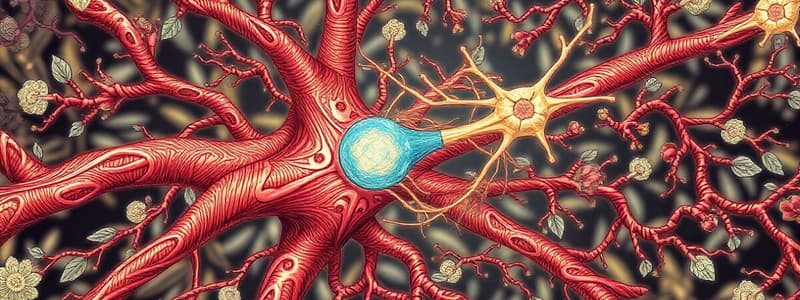Podcast
Questions and Answers
What is the primary function of the neuromuscular junction?
What is the primary function of the neuromuscular junction?
- To transmit signals from motor neurons to muscle fibers (correct)
- To regulate blood flow to muscles
- To enhance the strength of muscle contraction
- To store energy in muscle cells
Which component is NOT involved in the structure of the neuromuscular junction?
Which component is NOT involved in the structure of the neuromuscular junction?
- Motor neuron
- Muscle fiber
- Red blood cell (correct)
- Synaptic cleft
What substance is primarily released at the neuromuscular junction to initiate muscle contraction?
What substance is primarily released at the neuromuscular junction to initiate muscle contraction?
- Serotonin
- Dopamine
- Norepinephrine
- Acetylcholine (correct)
In the context of the neuromuscular junction, what does a synaptic cleft refer to?
In the context of the neuromuscular junction, what does a synaptic cleft refer to?
Which of the following best describes the role of calcium ions at the neuromuscular junction?
Which of the following best describes the role of calcium ions at the neuromuscular junction?
Flashcards are hidden until you start studying
Study Notes
Neuromuscular Junction (NMJ)
- The NMJ is a specialized synapse between a motor neuron and a muscle fiber
- The NMJ plays a crucial role in muscle contraction
- The NMJ is a highly regulated site for neurotransmitter release and signal transduction
Sequence of Events at the NMJ
- Presynaptic Terminal: An action potential travels down the motor neuron axon to the presynaptic terminal.
- Calcium Entry: The arrival of the action potential opens voltage-gated calcium channels at the presynaptic terminal, allowing calcium ions (Ca2+) to flow into the terminal.
- Vesicle Fusion and Neurotransmitter Release: Calcium influx triggers the fusion of synaptic vesicles containing the neurotransmitter acetylcholine (Ach) with the presynaptic membrane, releasing Ach into the synaptic cleft.
- Acetylcholine Diffusion: Ach diffuses across the synaptic cleft and binds to its receptors on the postsynaptic membrane, known as the motor end plate.
- Postsynaptic Membrane: The motor end plate contains nicotinic acetylcholine receptors which are ligand-gated ion channels.
- Sodium Influx: When Ach binds to its receptors on the motor end plate, these channels open, allowing sodium ions (Na+) to flow into the muscle fiber.
- Muscle Fiber Depolarization: The influx of sodium depolarizes the muscle fiber membrane and initiates an action potential that travels along the muscle fiber, leading to muscle contraction
Myasthenia Gravis
- Myasthenia Gravis is an autoimmune disease characterized by muscle weakness.
- Myasthenia Gravis is caused by the body's own immune system producing antibodies against the acetylcholine receptors on the motor end plate.
- These antibodies block or destroy the acetylcholine receptors, preventing acetylcholine from binding and initiating muscle contraction.
- This disruption of the neuromuscular junction leads to muscle weakness, fatigue, and difficulty with activities like walking, swallowing, and breathing.
- Treatments for Myasthenia Gravis include medications to increase acetylcholine levels, suppress the immune system, and remove the antibodies.
Studying That Suits You
Use AI to generate personalized quizzes and flashcards to suit your learning preferences.



